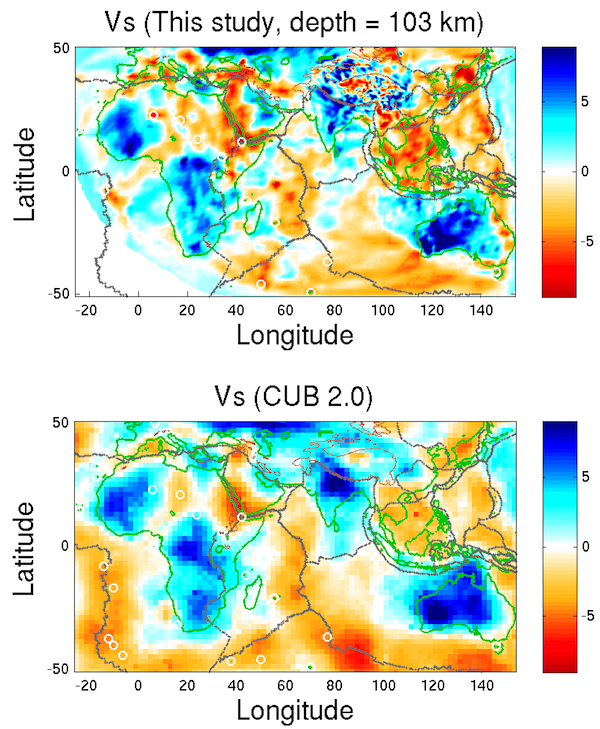2012 IRIS Workshop
Full-Wave Ambient Noise Tomography of the Eastern Hemisphere
Yang Shen:U Rhode Island, Wei Zhang:U Rhode Island
Figure 1. Comparison of the shear-wave velocity models at 103 km depth from full-wave ambient noise tomography (upper panel) and CUB 2.0 (lower panel, Shapiro and Ritzwoller, 2002). Color indicates the velocity perturbation in percentage relative to the average at the depth.

Full-resolution graphics file in original format: 0094.png
Our results differ from previous tomographic models in two important ways. First, a frequency-time normalization method is used to significantly improve the extraction of Rayleigh waves from ambient seismic noise (Shen et al., 2012). Empirical Green’s functions derived from up to 21 years of records show clear arrivals over a broad frequency range (7-600 s). The extremely broadband waves provide new constraints on the crust and the entire upper mantle, including the upper mantle transition zone. Second, we adapt a full-wave method based on simulation of wave propagation in 3D models in ambient noise imaging. We overcome the challenge of computing wave propagation in 3D models with a multigrid approach that allows wave-speed solutions to be passed from coarse to fine wave-simulation (and inversion) grids, and vice versa. The result is a comprehensive P and S velocity model of the crust and upper mantle for the eastern hemisphere that contains regions with variable resolutions.
Acknoweldgements: This work is supported by the National Science Foundation under grant EAR-0738779 and the U.S. Air Force Research Laboratory under award FA9453-10-C-0217.
For further reading: Shen, Y., Y. Ren, H. Gao, and B. Savage, An Improved Method to Extract Very Broadband Empirical Green's Functions From Ambient Seismic Noise, Bull. Seismol. Soc. Am., in press.
Keywords: full-wave_tomography, ambient_noise, crust, upper_mantle
